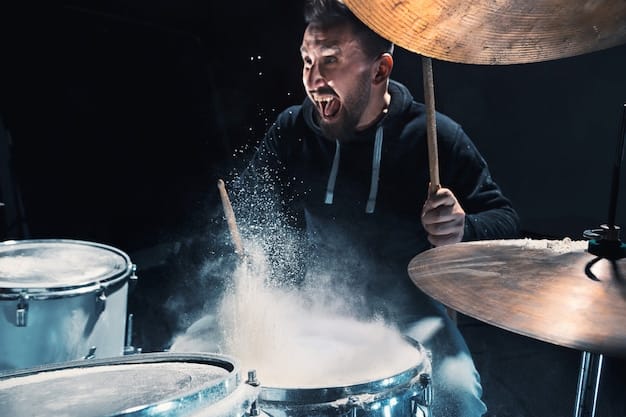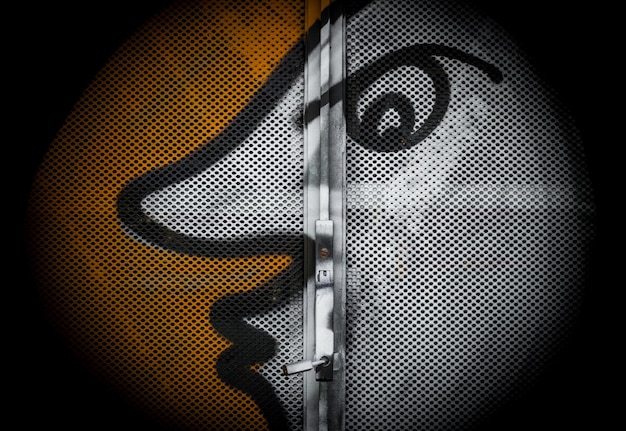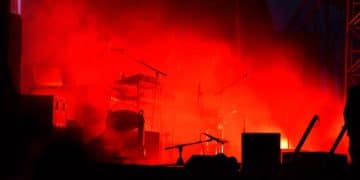Grindcore’s Extreme Sound: Decoding Blast Beats and Vocal Techniques

Grindcore’s Extreme Sound: Understanding Blast Beats and Vocal Techniques delves into the genre’s defining sonic features, exploring the high-speed drumming and intense vocal deliveries that characterize this extreme subgenre of metal.
Dive into the chaotic and utterly relentless world of grindcore! This article breaks down the key elements that define Grindcore’s Extreme Sound: Understanding Blast Beats and Vocal Techniques, from the hyper-speed drumming to the guttural vocal assaults that make it a unique and polarizing subgenre.
Grindcore: Defining the Extreme
Grindcore is known as one of the most extreme subgenres of metal, often pushing the boundaries of what’s considered musical. But what exactly defines this intense sound? It’s more than just noise; it’s a deliberate and highly technical form of musical expression.
The Core Elements of Grindcore
Grindcore’s intensity comes from a combination of factors, including its short song lengths, chaotic structures, and, most notably, its drumming and vocal styles. Understanding these aspects is crucial to appreciating the genre’s unique appeal.
Let’s explore the core elements that contribute to the extreme sounds within grindcore music.

- Blast Beats Expertise: The foundation of grindcore drumming, blast beats involve incredibly fast, alternating strokes between the snare and bass drum.
- Extreme Vocals Technique: Often guttural, high-pitched screams or growls, vocals are used more as a texture than for conveying traditional lyrics.
- Song Structure: Typically very short songs and erratic structures, grindcore challenges traditional song formats.
Grindcore’s distinctive elements work together to create a sonic landscape that’s both aggressive and artistically complex. It’s music designed to challenge and confront listeners.
Blast Beats: The Engine of Grindcore
Blast beats are the rhythmic backbone of grindcore, driving the music forward with relentless speed and power. Originating in extreme metal, they’ve become synonymous with the genre’s identity.
The Mechanics of a Blast Beat
A blast beat is characterized by rapid, alternating strokes between the snare drum and bass drum, often with the cymbal hits lining up with the snare. This creates a dense, almost constant wall of sound.
Blast beats are incredibly demanding, requiring a high degree of both skill and endurance to execute properly throughout song.
- Technique: Drummers use a variety of techniques, including heel-toe and swivel techniques, to achieve the necessary speed.
- Endurance: Maintaining blast beats for extended periods requires tremendous stamina and physical conditioning.
- Variations: There are several variations of blast beats, each with its own unique rhythmic flavor and level of complexity.
Mastering the blast beat is a rite of passage for any grindcore drummer, marking their entry into the upper echelons of extreme metal musicianship. It’s a hallmark of the genre.

Vocal Techniques: Beyond Traditional Singing
Grindcore vocals are far removed from traditional singing, often incorporating techniques like guttural screams, growls, and high-pitched shrieks. These vocalizations serve a purely sonic purpose, often sacrificing lyrical clarity.
The Spectrum of Grindcore Vocals
The grindcore vocal landscape is diverse, ranging from low, demonic growls to piercing, ear-splitting screams. This variety reflects the genre’s openness to experimentation and pushing boundaries.
Here’s some of the most known techniques of vocal within grindcore :
- Guttural Growls: Deep, throaty vocalizations create a sense of heaviness and aggression frequently used in death metal.
- High-Pitched Screams: Piercing shrieks add a layer of intensity and chaos to the music for an atonal experience for the listener.
- Pig Squeals: A controversial technique involving manipulating the vocal cords to mimic the sound of a pig squealing.
Grindcore vocalists often experiment with various effects and pedals to further distort and manipulate their voices, adding another layer of complexity to the sonic palette. It’s all about creating extreme sounds.
Influences and Evolution of Grindcore
Grindcore emerged in the mid-1980s, drawing influences from various extreme music genres. Understanding its roots helps to appreciate its unique position in the metal landscape.
The Melting Pot of Genres
Grindcore’s origins can be traced to a combination of hardcore punk, thrash metal, and early death metal. Bands like Siege, Repulsion, and Napalm Death are considered pioneers of the genre, each bringing their unique flavor to the mix.
Let us check some of the influences in time that impacted grindcore artists:
- Hardcore Punk: Provided the DIY ethos and politically charged lyrics for a new generation of bands.
- Thrash Metal: Contributed its speed, aggression, and technical playing skill.
- Death Metal: Introduced the concept of guttural vocals and themes of extreme violence and morbidity.
Incorporating those elements as the basis, grindcore came to change music and the metalheads scene.
The Impact and Legacy of Grindcore
Despite its extreme nature, grindcore has had a significant impact on the metal scene, influencing countless bands and inspiring new subgenres. Its legacy continues to grow.
Grindcore’s Enduring Influence
Grindcore’s influence can be heard in various subgenres, including deathgrind, pornogrind, and noisegrind. Its emphasis on speed, intensity, and experimentation has pushed the boundaries of extreme music.
Let’s dive deeper into grindcore so future generations can hear and experience:
- Technical Death Metal: In the present day, Grindcore inspired death metal bands to incorporate blast beats and complex riffing.
- Experimental Music: Many experimental musicians have drawn inspiration from grindcore’s use of noise and dissonance.
- DIY Culture: Grindcore’s DIY approach to music production and distribution continues to inspire independent artists.
Exploring and researching about the Grindcore scene can be a rewarding and informative experience to dive into the history of musical genres and artists.
Appreciating the Art of Noise
While grindcore may not be for everyone, it represents a unique and challenging form of artistic expression. Understanding its core elements and historical context can provide a deeper appreciation for its place in music history.
The Value of Extreme Art
Grindcore challenges listeners to confront uncomfortable sounds and ideas and it pushes the boundaries of what music can be, prompting us to question our preconceived notions.
Check some thoughts when experiencing a grindcore song:
- Emotional Outlet: For many, grindcore provides a cathartic release.
- Artistic Exploration: Grindcore demonstrates the potential for extreme music on art and artistic expression.
- Community: It creates a sense of solidarity among musicians and fans who share a passion for extreme sounds.
Although Grindcore is a niché subgenre, it is responsible to inspire tons of bands and subgenres as well. The impact that it made and continues to make is undeniable.
| Key Aspect | Brief Description |
|---|---|
| 🥁 Blast Beats | High-speed drumming with alternating snare and bass. |
| 🎤 Extreme Vocals | Guttural growls, screams, and other unconventional techniques. |
| ⏱️ Short Songs | Tracks are typically very brief, often under two minutes. |
| 🤘 Influences | Influenced by hardcore punk, thrash, and death metal. |
Frequently Asked Questions
Grindcore is characterized by its extreme speed, short song lengths, blast beats, and unconventional vocal techniques such as guttural and high pitch screams.
Blast beats are a drumming technique which include fast alternating strokes between the snare and bass drum. They provides the rhythmic complexity, crucial for grindcore’s intensity and chaos.
Grindcore vocals typically include guttural growls, high-pitched screams, and pig squeals. These unconventional styles contribute to the genre’s harsh sound.
Grindcore emerged in the 1980s, blending hardcore punk, thrash metal, and death metal. Bands like Napalm Death pioneered the genre.
Grindcore has influenced various subgenres, pushing experimental boundaries. Its DIY culture has inspired independent artists in the metal community to create and explore.
Conclusion
Grindcore’s extreme sound, defined by its blistering blast beats and visceral vocal techniques, represents more than just noise; it’s a challenging and influential form of musical expression. Understanding its core elements offers a new appreciation to the niché subgenre





